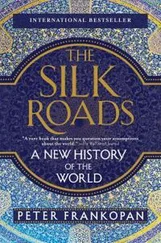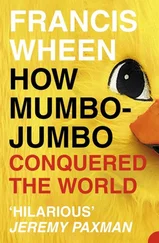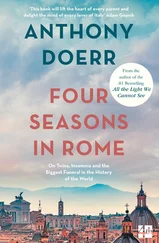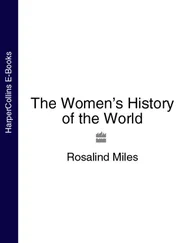Herbert Wells - A Short History of the World
Здесь есть возможность читать онлайн «Herbert Wells - A Short History of the World» весь текст электронной книги совершенно бесплатно (целиком полную версию без сокращений). В некоторых случаях можно слушать аудио, скачать через торрент в формате fb2 и присутствует краткое содержание. Год выпуска: 2011, Жанр: История, на английском языке. Описание произведения, (предисловие) а так же отзывы посетителей доступны на портале библиотеки ЛибКат.
- Название:A Short History of the World
- Автор:
- Жанр:
- Год:2011
- ISBN:нет данных
- Рейтинг книги:4 / 5. Голосов: 1
-
Избранное:Добавить в избранное
- Отзывы:
-
Ваша оценка:
- 80
- 1
- 2
- 3
- 4
- 5
A Short History of the World: краткое содержание, описание и аннотация
Предлагаем к чтению аннотацию, описание, краткое содержание или предисловие (зависит от того, что написал сам автор книги «A Short History of the World»). Если вы не нашли необходимую информацию о книге — напишите в комментариях, мы постараемся отыскать её.
A Short History of the World — читать онлайн бесплатно полную книгу (весь текст) целиком
Ниже представлен текст книги, разбитый по страницам. Система сохранения места последней прочитанной страницы, позволяет с удобством читать онлайн бесплатно книгу «A Short History of the World», без необходимости каждый раз заново искать на чём Вы остановились. Поставьте закладку, и сможете в любой момент перейти на страницу, на которой закончили чтение.
Интервал:
Закладка:
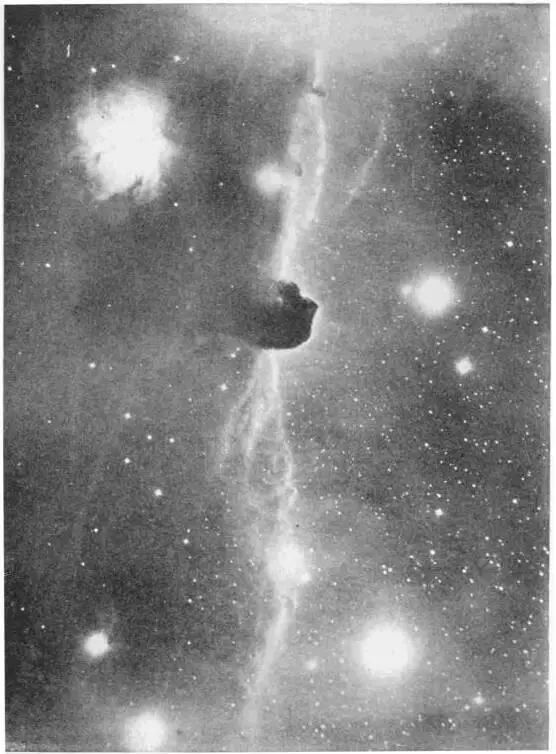
A DARK NEBULA Taken in 1920 with the aid of the largest telescope in the world. One of the first photographs taken by the Mount Wilson telescope.
There are dark nebulæ and bright nebulæ. Prof. Henry Norris Russell, against the British theory, holds that the dark nebulæ preceded the bright nebulæ.
Photo: Prof. Hale
Slowly by degrees as one million of years followed another, this fiery scene would lose its eruptive incandescence. The vapours in the sky would rain down and become less dense overhead; great slaggy cakes of solidifying rock would appear upon the surface of the molten sea, and sink under it, to be replaced by other floating masses. The sun and moon growing now each more distant and each smaller, would rush with diminishing swiftness across the heavens. The moon now, because of its smaller size, would be already cooled far below incandescence, and would be alternately obstructing and reflecting the sunlight in a series of eclipses and full moons.
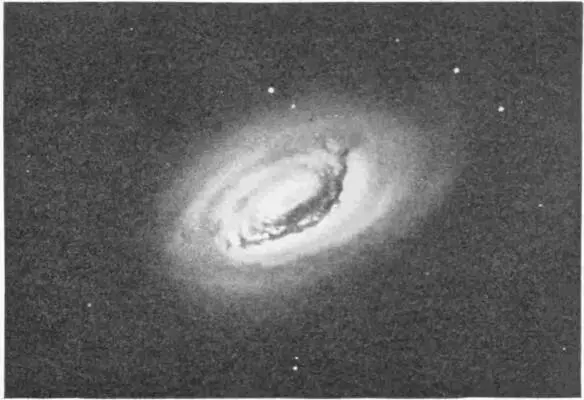
ANOTHER SPIRAL NEBULA
Photo: G. W. Ritchey
And so with a tremendous slowness through the vastness of time, the earth would grow more and more like the earth on which we live, until at last an age would come when, in the cooling air, steam would begin to condense into clouds, and the first rain would fall hissing upon the first rocks below. For endless millenia the greater part of the earth’s water would still be vaporized in the atmosphere, but there would now be hot streams running over the crystallizing rocks below and pools and lakes into which these streams would be carrying detritus and depositing sediment.
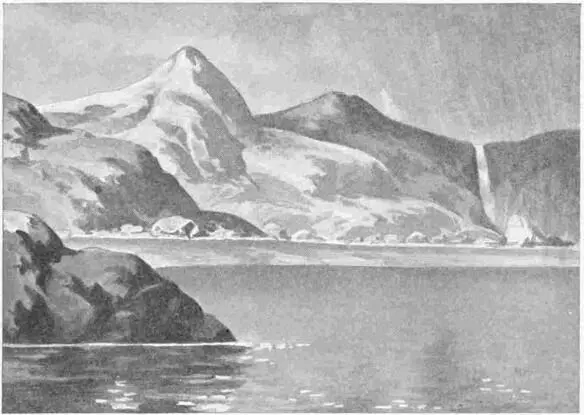
LANDSCAPE BEFORE LIFE “Great lava-like masses of rock without traces of soil”
At last a condition of things must have been attained in which a man might have stood up on earth and looked about him and lived. If we could have visited the earth at that time we should have stood on great lava-like masses of rock without a trace of soil or touch of living vegetation, under a storm-rent sky. Hot and violent winds, exceeding the fiercest tornado that ever blows, and downpours of rain such as our milder, slower earth to-day knows nothing of, might have assailed us. The water of the downpour would have rushed by us, muddy with the spoils of the rocks, coming together into torrents, cutting deep gorges and canyons as they hurried past to deposit their sediment in the earliest seas. Through the clouds we should have glimpsed a great sun moving visibly across the sky, and in its wake and in the wake of the moon would have come a diurnal tide of earthquake and upheaval. And the moon, which nowadays keeps one constant face to earth, would then have been rotating visibly and showing the side it now hides so inexorably.
The earth aged. One million years followed another, and the day lengthened, the sun grew more distant and milder, the moon’s pace in the sky slackened; the intensity of rain and storm diminished and the water in the first seas increased and ran together into the ocean garment our planet henceforth wore.
But there was no life as yet upon the earth; the seas were lifeless, and the rocks were barren.
III
THE BEGINNINGS OF LIFE
AS everybody knows nowadays, the knowledge we possess of life before the beginnings of human memory and tradition is derived from the markings and fossils of living things in the stratified rocks. We find preserved in shale and slate, limestone, and sandstone, bones, shells, fibres, stems, fruits, footmarks, scratchings and the like, side by side with the ripple marks of the earliest tides and the pittings of the earliest rain-falls. It is by the sedulous examination of this Record of the Rocks that the past history of the earth’s life has been pieced together. That much nearly everybody knows to-day. The sedimentary rocks do not lie neatly stratum above stratum; they have been crumpled, bent, thrust about, distorted and mixed together like the leaves of a library that has been repeatedly looted and burnt, and it is only as a result of many devoted lifetimes of work that the record has been put into order and read. The whole compass of time represented by the record of the rocks is now estimated as 1,600,000,000 years.
The earliest rocks in the record are called by geologists the Azoic rocks, because they show no traces of life. Great areas of these Azoic rocks lie uncovered in North America, and they are of such a thickness that geologists consider that they represent a period of at least half of the 1,600,000,000 which they assign to the whole geological record. Let me repeat this profoundly significant fact. Half the great interval of time since land and sea were first distinguishable on earth has left us no traces of life. There are ripplings and rain marks still to be found in these rocks, but no marks nor vestiges of any living thing.
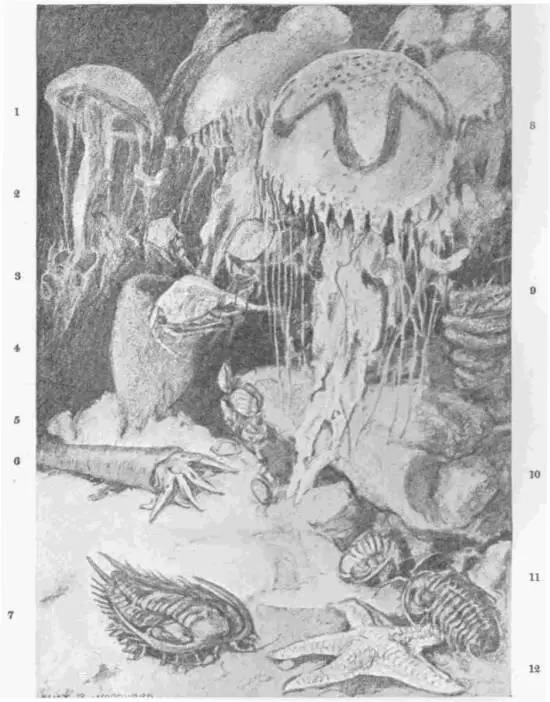
MARINE LIFE IN THE CAMBRIAN PERIOD 1 and 8, Jellyfishes; 2, Hyolithes (swimming snail); 3, Humenocaris; 4, Protospongia; 5, Lampshells (Obolella); 6, Orthoceras; 7, Trilobite (Paradoxides) — see fossil on page 13; 9, Coral (Archæocyathus); 10, Bryograptus; 11, Trilobite (Olenellus); 12, Palesterina
Then, as we come up the record, signs of past life appear and increase. The age of the world’s history in which we find these past traces is called by geologists the Lower Palæozoic age. The first indications that life was astir are vestiges of comparatively simple and lowly things: the shells of small shellfish, the stems and flowerlike heads of zoophytes, seaweeds and the tracks and remains of sea worms and crustacea. Very early appear certain creatures rather like plant-lice, crawling creatures which could roll themselves up into balls as the plant-lice do, the trilobites. Later by a few million years or so come certain sea scorpions, more mobile and powerful creatures than the world had ever seen before.
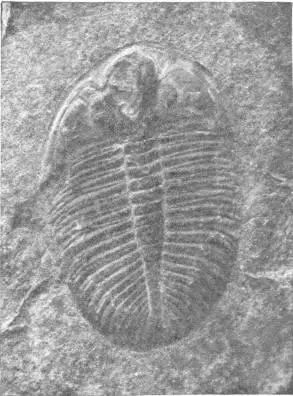
FOSSIL TRILOBITE (SLIGHTLY MAGNIFIED)
Photo: John J. Ward, F.E.S.
None of these creatures were of very great size. Among the largest were certain of the sea scorpions, which measured nine feet in length. There are no signs whatever of land life of any sort, plant or animal; there are no fishes nor any vertebrated creatures in this part of the record. Essentially all the plants and creatures which have left us their traces from this period of the earth’s history are shallow-water and intertidal beings. If we wished to parallel the flora and fauna of the Lower Palæozoic rocks on the earth to-day, we should do it best, except in the matter of size, by taking a drop of water from a rock pool or scummy ditch and examining it under a microscope. The little crustacea, the small shellfish, the zoophytes and algæ we should find there would display a quite striking resemblance to these clumsier, larger prototypes that once were the crown of life upon our planet.
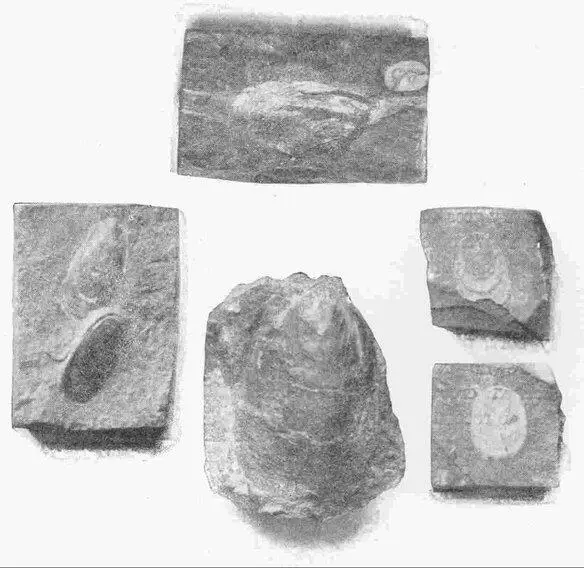
Интервал:
Закладка:
Похожие книги на «A Short History of the World»
Представляем Вашему вниманию похожие книги на «A Short History of the World» списком для выбора. Мы отобрали схожую по названию и смыслу литературу в надежде предоставить читателям больше вариантов отыскать новые, интересные, ещё непрочитанные произведения.
Обсуждение, отзывы о книге «A Short History of the World» и просто собственные мнения читателей. Оставьте ваши комментарии, напишите, что Вы думаете о произведении, его смысле или главных героях. Укажите что конкретно понравилось, а что нет, и почему Вы так считаете.

